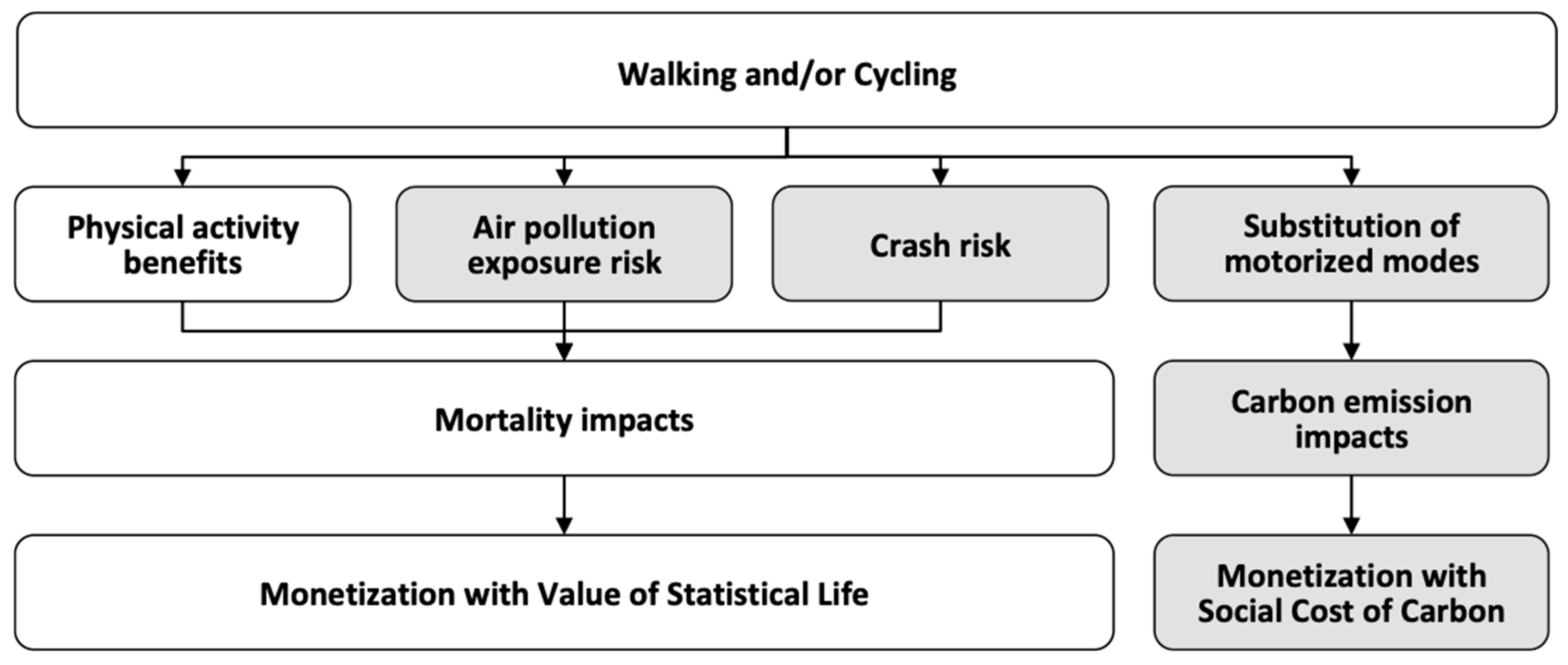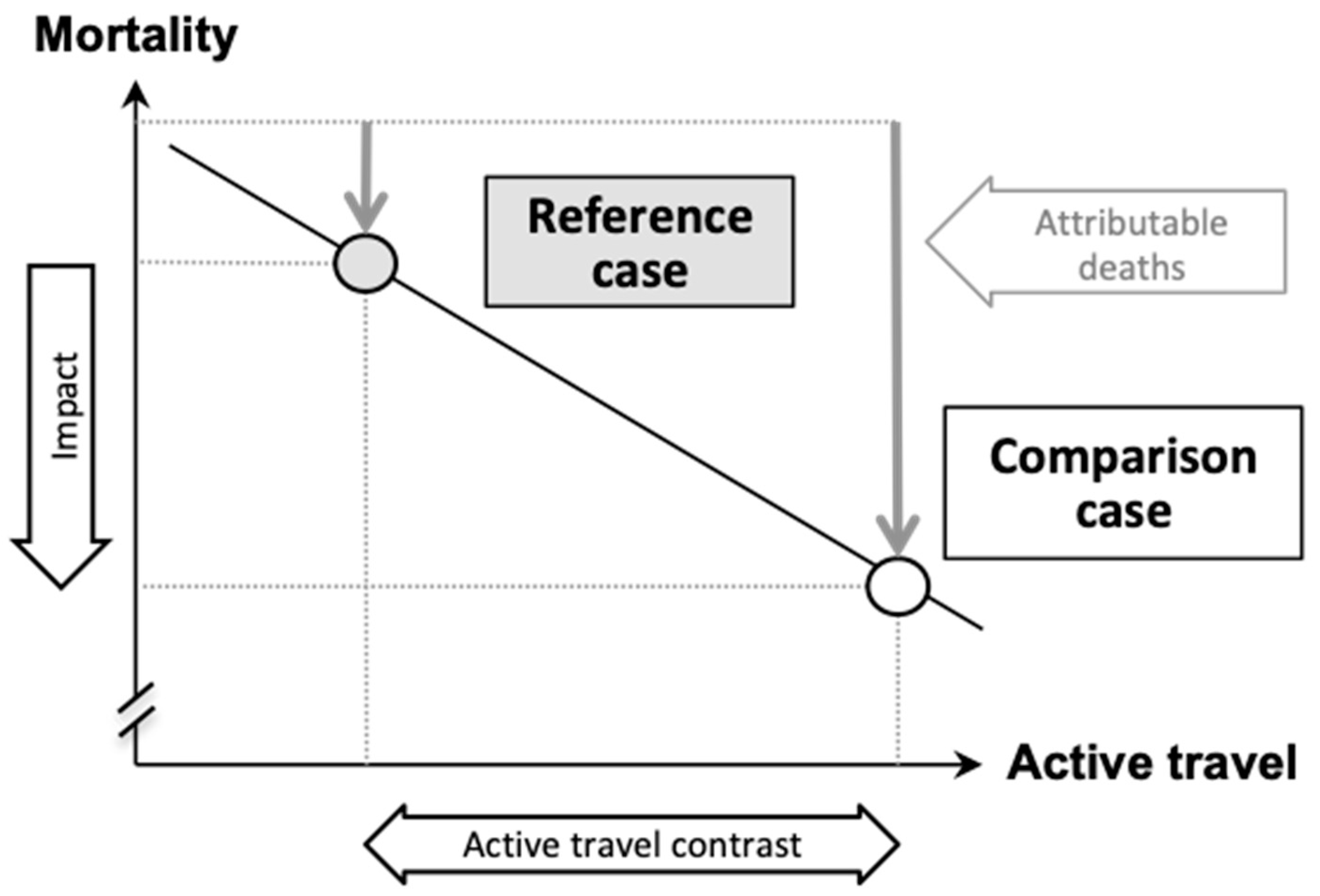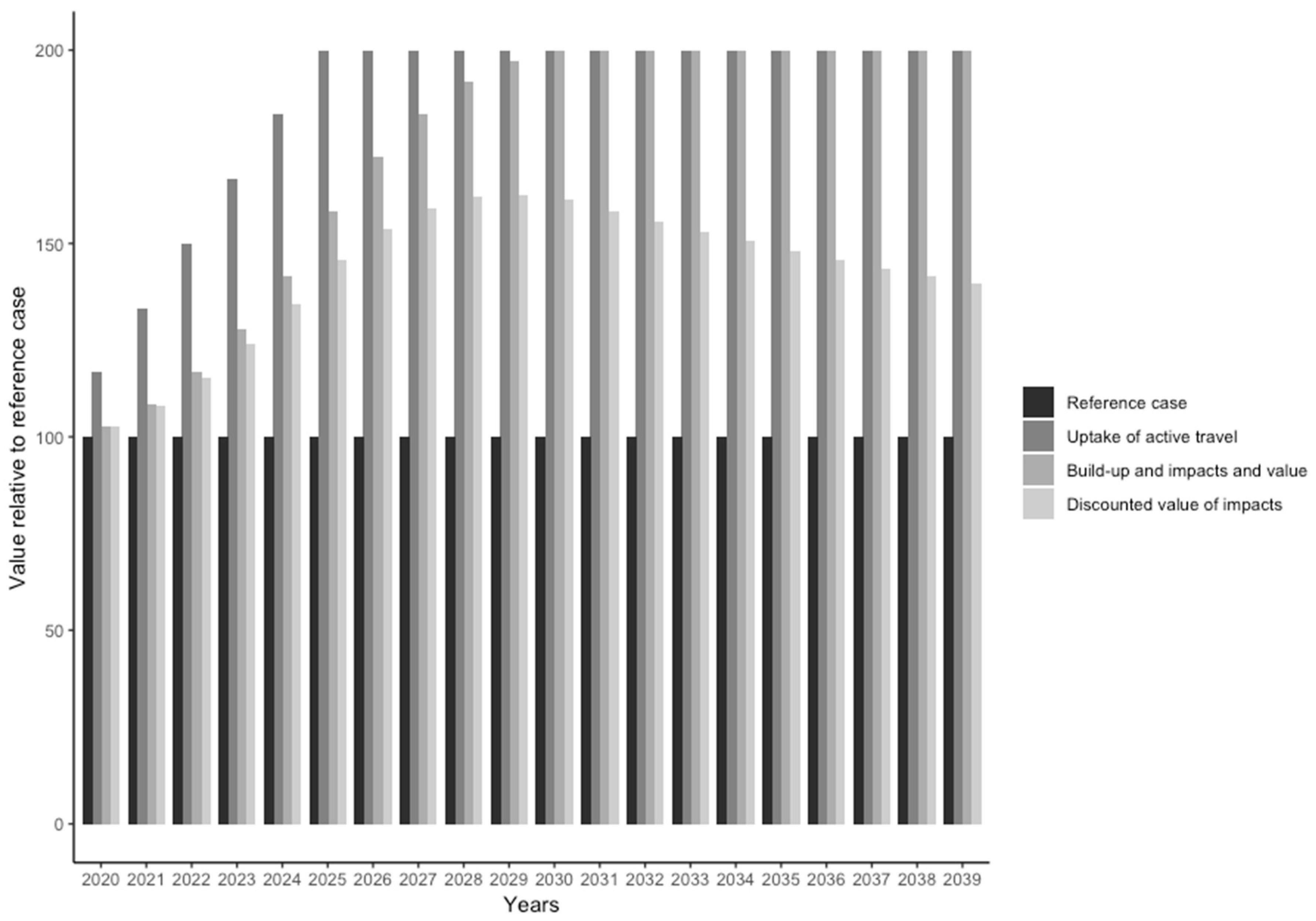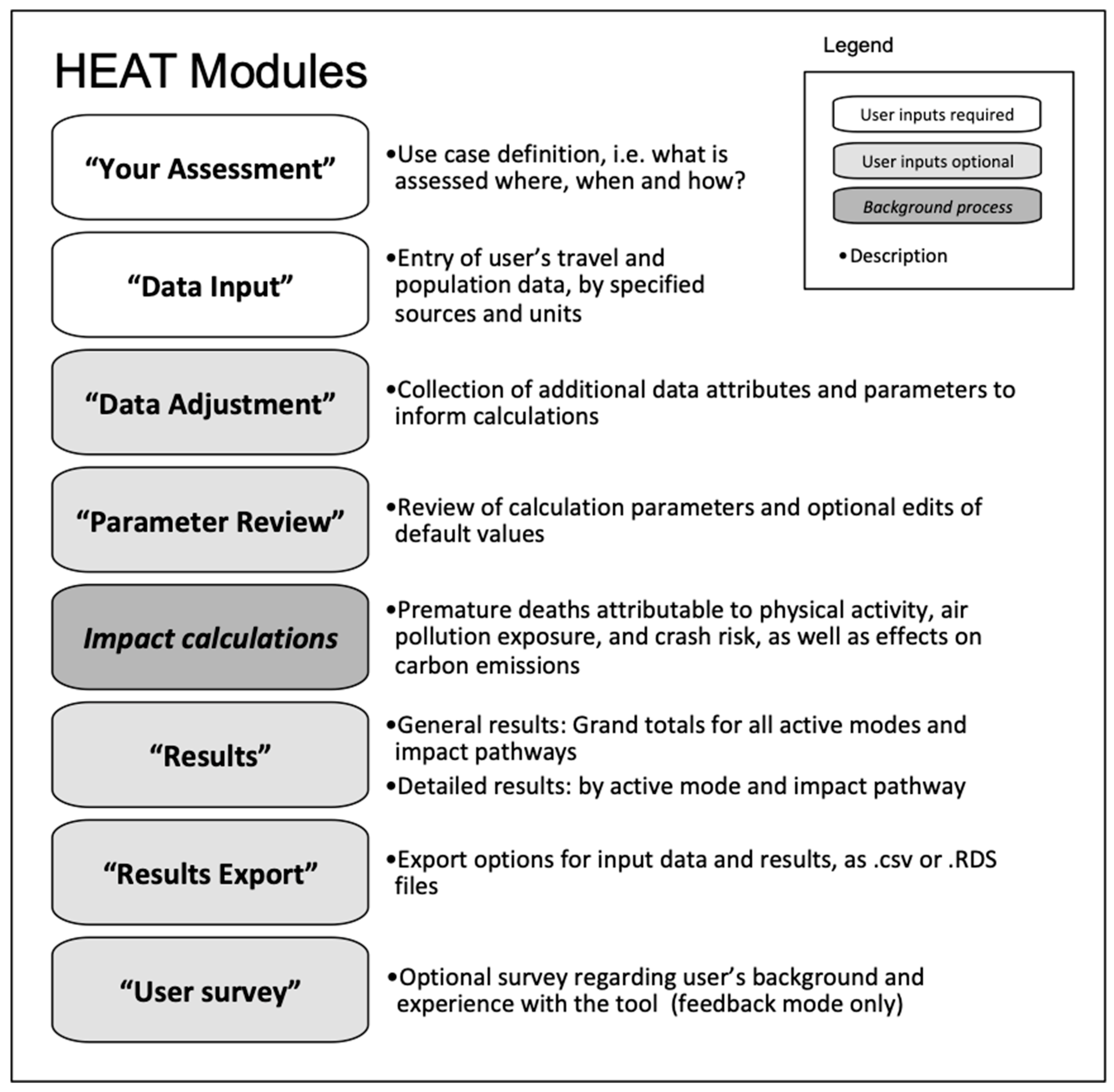Integrated Impact Assessment of Active Travel: Expanding the Scope of the Health Economic Assessment Tool (HEAT) for Walking and Cycling
Abstract
1. Introduction
2. Materials and Methods
2.1. Overview and Rationale
2.1.1. Basic HEAT Approach: Comparative Risk Assessment
2.1.2. Temporality in HEAT
- (1)
- “Uptake time” specifies how long it takes to reach the maximum contrast in active travel levels (i.e., from reference to comparison levels). This considers the notion that once a new intervention/policy is established, it will take some time before it unfolds its full potential in increasing active travel. The tool sets up a year-sequence and linearly interpolates corresponding active travel volumes. The default value of one year can be modified by the user;
- (2)
- “Build-up time” is a pre-defined lag period over which travel volumes develop the full health impacts of physical activity and air pollution, and is set to 5 years, based on expert consensus [13]. The build-up of full-magnitude health effects is interpolated linearly over the build-up time;
- (3)
- “Change in crash risk” allows the user to specify a lower or higher crash risk for the comparison case, which the tool will interpolate linearly over the assessment period;
- (4)
- “Economic discounting”, finally, adjusts the monetized annual impacts to their actual values in a user-defined year (by default the current year), considering the economic notion that benefits in the more distant future are of lower value than benefits that occur in the present or less distant future.
2.2. Tool Features
2.2.1. Use Case Definitions
- (1)
- Active travel mode(s) assessed, namely walking and/or cycling. For the future, additional modes, such as bike sharing and e-bikes, are under consideration;
- (2)
- Geographic scale of the assessment. Country and city are specified, based on which the tool pulls data on mortality rates, air pollution levels, crash risks and carbon emissions from underlying datasets (to the extent available, see also Section 2.2.2). Currently, countries and cities within the 53 Member States of the WHO European Region are supported. An expansion to accommodate other, non-preset use cases is under way, including the option of global applications. The user can also specify to conduct a sub-city assessment, which refers to the evaluation of specific facilities, infrastructures, neighborhoods, or similar. This has some methodological implications. For example, count data can only be used for sub-city assessments, because the extrapolation from count data to area-wide (i.e., city- or country-wide) levels of active travel remains extremely challenging. Crash risk assessments, on the other hand, are only offered for cycling and for selected countries, because the availability of crash risk estimates is very limited. Similarly, carbon emission assessments are performed using country-specific travel activity, vehicle fleet and temperature data.
- (3)
- Comparison and time scale, i.e., whether to conduct a single-case or a two-case assessment, and when and for how long the assessment takes place.
- (4)
- Impacts that should be considered, namely for the physiological pathways of exposure to physical activity, air pollution, crash risks, and/or carbon emissions.
- (5)
- Motorized modes, i.e., whether the user has travel activity data for motorized modes or wants to use default data (currently for carbon emissions only).
2.2.2. Background Data
- mortality rates by country and age ranges (i.e., 20–44, 45–64, 45–74, 20–64, 20–74);
- air pollution levels for countries and cities (ambient particulate matter of less than 2.5 or 10μm in median diameter, respectively (PM2.5 or PM10));
- road fatality rates per distance cycled in selected countries [14];
- carbon emission factors for various travel modes, by country, as projected until 2050 (derived from international databases such as IIASA’s GAINS model, and speed-emissions curves building on EEA’s COPERT V model);
- value of statistical life estimates [15], by country.
2.2.3. Data Input
- hypothetical scenario (hypothesized active travel levels);
- population survey (measured/observed active travel levels, e.g., from travel survey);
- intercept survey (location-based, recommended only for sub-city assessments);
- count data (location-based, recommended only for sub-city assessments);
- modeled data;
- app-based data (mobile phone/wearable device).
- minutes (per person, per day);
- hours (per person, per day);
- kilometers (per person, per day);
- miles (per person, per day);
- trips (per person, per day);
- counts (continuous, short-term; per location, per day);
- steps (walking only; per person, per day);
- frequency categories (percent of population);
- mode share (percent of total travel by all modes).
- young adults (20–44);
- average (20–64 for cycling, 20–74 for walking);
- older adults (45–64 for cycling, 45–74 for walking).
2.2.4. Data Adjustment
- they can exclude some active travel (e.g., if attributed to a general trend in active travel that is not related to the intervention of interest);
- they can account for some build-up time until the comparison levels of active travel are reached;
- they can correct count data for seasonal or geographic distortion;
- they can quantify to what extent active travel may substitute other forms of physical activity.
- proportion in traffic vs. away from traffic (informing pollution levels assigned to the comparison case);
- proportion for transport purposes vs. leisure (informing pollution levels in the reference case).
- proportion of new trips (i.e., induced travel not replacing previous travel)
- proportion of reassigned trips (i.e., trips that previously took place on a different route by the same mode);
- proportions shifted from other modes (i.e., walking, cycling, and various motorized mode categories).
2.2.5. Impact Calculations
Physical Activity
Air Pollution
Crash Risk
Carbon Emissions
2.2.6. Impacts Aggregation, Monetization and Results Presentation
2.3. Technical Implementation
2.4. User Testing and Refinement
3. Discussion
- Assessments of status quo, comparisons or changes of walking and/or cycling levels;
- Assessments at national, city or local project level;
- Optional consideration of motorized modes;
- Assessment of health impacts in terms of mortality due to physical activity, exposure to air pollution and crash risk;
- Assessment of impacts on carbon emissions;
- Monetization of impacts.
- HEAT still only assesses mortality. This is not for lack of evidence about the effects of active travel on morbidities, i.e., cardio-vascular diseases and others, but for the reason of keeping the tool simple. Users interested in assessing impacts on morbidities may consider more complex tools, such as the Integrated Transport and Health Impact Model (ITHIM) [37], or conduct their own custom analysis;
- HEAT only considers impacts on adult populations. HEAT excludes subjects younger than 20 years old from the analysis, because first of all, mortality in these age ranges is very small, and second, for that same reason, there are no studies available for the effects of physical activity on mortality in these age ranges. HEAT further excludes subjects older than 74 years (for walking) or 64 years (for cycling), because mortality risks increase dramatically in older age ranges. Including these would therefore be highly influential on the results and potentially inflate the benefits of active travel;
- While the aim is to enable users to use their data as much as possible in the format they collect or obtain them, the task of aggregating the active travel data to population averages for the two comparison cases is left to the user. As such, HEAT is indifferent to any non-linear patterns in active travel developments that may be captured by sophisticated data sources or models, such as, for example, agent-based models;
- HEAT only considers the effects for active travelers (albeit averaged across the general population). The effects of active travel on the general population, for example through lower air pollution or increased traffic safety, are not assessed;
- Crash risk assessments are only available for cycling in selected countries, and at the country or city level. Crash risk assessments at lower geographic scales, such as for specific infrastructures or road segments, are not considered feasible because the data collection or modeling required to obtain such crash risk estimates remains extremely challenging;
- HEAT currently only allows for a crude reflection of the age of the assessed population. Substantial deviations in the age of the assessed population compared to the specified age range may result in substantial inaccuracies.
4. Conclusions
Author Contributions
Funding
Acknowledgments
Conflicts of Interest
Disclaimer
References
- Rutter, H.; Cavill, N.; Dinsdale, H.; Kahlmeier, S.; Racioppi, F.; Oja, P. Health Economic Assessment Tool for Cycling—User Guide; World Health Organization Regional Office Europe: Rome, Italy, 2008; Version 2. [Google Scholar]
- Cavill, N.; Kahlmeier, S.; Rutter, H.; Racioppi, F.; Oja, P. Economic Assessment of Transport Infrastructure and Policies—Methodological Guidance on the Appraisal of Health Effects Related to Walking and Cycling; World Health Organization Europe: Copenhagen, Denmark, 2007. [Google Scholar]
- Cavill, N.; Kahlmeier, S. Turn up the Heat; European Cyclists’ Federation: Brussels, Belgium, 2016. [Google Scholar]
- Brown, V.; Diomedi, B.Z.; Moodie, M.; Veerman, J.L.; Carter, R. A systematic review of economic analyses of active transport interventions that include physical activity benefits. Transp. Policy 2016, 45, 190–208. [Google Scholar] [CrossRef]
- de Hartog, J.J.; Boogaard, H.; Nijland, H.; Hoek, G. Do the Health Benefits of Cycling Outweigh the Risks? Environ. Health Perspect. 2010, 118, 1109–1116. [Google Scholar] [CrossRef] [PubMed]
- Mueller, N.; Rojas-Rueda, D.; Cole-Hunter, T.; de Nazelle, A.; Dons, E.; Gerike, R.; Götschi, T.; Int Panis, L.; Kahlmeier, S.; Nieuwenhuijsen, M. Health impact assessment of active transportation: A systematic review. Prev. Med. 2015, 76, 103–114. [Google Scholar] [CrossRef] [PubMed]
- Doorley, R.; Pakrashi, V.; Ghosh, B. Quantifying the Health Impacts of Active Travel: Assessment of Methodologies. Transp. Rev. 2015, 35, 559–582. [Google Scholar] [CrossRef]
- Tainio, M.; de Nazelle, A.J.; Götschi, T.; Kahlmeier, S.; Rojas-Rueda, D.; Nieuwenhuijsen, M.J.; de Sá, T.H.; Kelly, P.; Woodcock, J. Can Air Pollution Negate the Health Benefits of Cycling and Walking? Prev. Med. 2016, 87, 233–236. [Google Scholar] [CrossRef] [PubMed]
- Woodcock, J.; Tainio, M.; Cheshire, J.; O’Brien, O.; Goodman, A. Health effects of the London bicycle sharing system: Health impact modelling study. BMJ Br. Med. J. 2014, 348, g425. [Google Scholar] [CrossRef]
- Lieb, C.; Sommer, H.; Amacher, M.; Götschi, T.; Kahlmeier, S.; Sutter, D. Integration des Langsamverkehrs in die Transportrechnung; ARE/BFS: Bern, Switzerland, 2013. [Google Scholar]
- Kahlmeier, S.; Cavill, N.; Dinsdale, H.; Rutter, H.; Gotschi, T.; Foster, C.; Kelly, P.; Oja, P.; Fordham, R.; Stone, D.; et al. Health Economic Assessment Tools (HEAT) for Walking and for Cycling. Methodology and User Guide; WHO Regional Office for Europe: Copenhagen, Denmark, 2011; ISBN 978-92-890-0251-6. [Google Scholar]
- Brand, C.; Goodman, A.; Ogilvie, D. Evaluating the impacts of new walking and cycling infrastructure on carbon dioxide emissions from motorized travel: A controlled longitudinal study. Appl. Energy 2014, 128, 284–295. [Google Scholar] [CrossRef]
- WHO/Europe. Development of the Health Economic Assessment Tools (HEAT) for Walking and Cycling. 5th Consensus Meeting: Meeting Report; World Health Organization Regional Office for Europe: Copenhagen, Denmark, 2017. [Google Scholar]
- Castro, A.; Kahlmeier, S.; Gotschi, T. Exposure-Adjusted Road Fatality Rates for Cycling and Walking in European Countries; International Transport Forum: Paris, France, 2018. [Google Scholar]
- OECD. Mortality Risk Valuation in Environment, Health and Transport Policies; OECD: Paris, France, 2012. [Google Scholar]
- Kahlmeier, S.; Götschi, T.; Cavil, N.; Castro Fernandez, A.; Brand, C.; Rojas Rueda, D.; Woodcock, J.; Kelly, P.; Lieb, C.; Oja, P.; et al. Health economic Assessment Tool (HEAT) for Walking and for Cycling. Methods and User Guide on Physical Activity, Air Pollution, Injuries and Carbon Impact Assessments (2017); World Health Organization, Regional Office for Europe: Brussels, Belgium, 2017. [Google Scholar]
- WHO/Europe Health Economic Assessment Tool (HEAT) for Walking and Cycling. Available online: www.heatwalkingcycling.org (accessed on 1 July 2019).
- 2018 Physical Activity Guidelines Advisory Committee. 2018 Physical Activity Guidelines Advisory Committee Scientific Report; U.S. Department of Health and Human Services: Washington, DC, USA, 2018.
- Kelly, P.; Kahlmeier, S.; Gotschi, T.; Orsini, N.; Richards, J.; Roberts, N.; Scarborough, P.; Foster, C. Systematic review and meta-analysis of reduction in all-cause mortality from walking and cycling and shape of dose response relationship. Int. J. Behav. Nutr. Phys. Act. 2014, 11, 132. [Google Scholar] [CrossRef]
- WHO. Metrics: Population Attributable Fraction (PAF); WHO: Geneva, Switzerland, 2014. [Google Scholar]
- Hoek, G.; Krishnan, R.M.; Beelen, R.; Peters, A.; Ostro, B.; Brunekreef, B. Long-term air pollution exposure and cardio- respiratory mortality: A review. Environ. Health 2013, 12, 43. [Google Scholar] [CrossRef]
- Beelen, R.; Raaschou-Nielsen, O.; Stafoggia, M.; Andersen, Z.J.; Weinmayr, G.; Hoffmann, B.; Wolf, K.; Samoli, E.; Fischer, P.; Nieuwenhuijsen, M.; et al. Effects of long-term exposure to air pollution on natural-cause mortality: An analysis of 22 European cohorts within the multicentre ESCAPE project. Lancet 2014, 383, 785–795. [Google Scholar] [CrossRef]
- Mueller, N.; Rojas-Rueda, D.; Basagaña, X.; Cirach, M.; Cole-Hunter, T.; Dadvand, P.; Donaire-Gonzalez, D.; Foraster, M.; Gascon, M.; Martinez, D.; et al. Urban and transport planning related exposures and mortality: A health impact assessment for cities. Environ. Health Perspect. 2017, 125, 89–96. [Google Scholar] [CrossRef]
- Rojas-Rueda, D.; de Nazelle, A.; Tainio, M.; Nieuwenhuijsen, M.J. The health risks and benefits of cycling in urban environments compared with car use: Health impact assessment study. Br. Med. J. 2011, 343, d4521. [Google Scholar] [CrossRef]
- WHO. WHO Expert Meeting: Methods and Tools for Assessing the Health Risks of AIR pollution at Local, National and International Level; WHO: Geneva, Switzerland, 2014. [Google Scholar]
- Johnson, T. A Guide to Selected Algorithms, Distributions, and Databases Used in Exposure Models Developed by the Office of Air Quality Planning and Standards; TRJ Environmental, Inc.: Chapel Hill, NC, USA, 2002. [Google Scholar]
- de Nazelle, A.; Bode, O.; Orjuela, J.P. Comparison of air pollution exposures in active vs. passive travel modes in European cities: A quantitative review. Environ. Int. 2017, 99, 151–160. [Google Scholar] [CrossRef] [PubMed]
- Götschi, T.; Garrard, J.; Giles-Corti, B. Cycling as a Part of Daily Life: A Review of Health Perspectives. Transp. Rev. 2015, 36, 45–71. [Google Scholar] [CrossRef]
- Aldred, R.; Goodman, A.; Gulliver, J.; Woodcock, J. Cycling injury risk in London: A case-control study exploring the impact of cycle volumes, motor vehicle volumes, and road characteristics including speed limits. Accid. Anal. Prev. 2018, 117, 75–84. [Google Scholar] [CrossRef]
- Mason, J.; Fulton, L.; Mcdonald, Z.; Mayne, C.; Pardo, C.; Cherry, B.; Margevicius, M.; Replogle, R.; Neufeld, A.; Leal, G.; et al. A Global High Shift Cycling Scenario: The Potential for Dramatically Increasing Bicycle and E-bike Use in Cities around the World, with Estimated Energy, CO2, and Cost Impacts; Institute for Transportation & Development Policy and the University of California: Davis, CA, USA, 2015. [Google Scholar]
- RStudio. Available online: www.shiny.rstudio.com (accessed on 1 July 2019).
- Department for Transport. TAG UNIT A5.1 Active Mode Appraisal; Department for Transport: London, UK, 2018.
- BMLFUW. Investitionen in Unsere Umweltfreundliche Mobilitätszukunft. Leistungsbericht; Bundesministerium für Land- und Forstwirtschaft, Umwelt und Wasserwirtschaft: Wien, Austria, 2016. [Google Scholar]
- Götschi, T.; Kahlmeier, S. Ökonomische Abschätzung der volkswirtschaftlichen Gesundheitsnutzen des Langsamverkehrs in der Schweiz; ASTRA Langsamverkehr, Ed.; Institut für Sozial- und Präventivmedizin, Universität Zürich: Zurich, Switzerland, 2012. [Google Scholar]
- Transport for London. Valuing the Health Benefits of Transport Schemes: Guidance for London; Transport for London: London, UK, 2015.
- Haines, A.; McMichael, A.J.; Smith, K.R.; Roberts, I.; Woodcock, J.; Markandya, A.; Armstrong, B.G.; Campbell-Lendrum, D.; Dangour, A.D.; Davies, M.; et al. Public health benefits of strategies to reduce greenhouse-gas emissions: Overview and implications for policy makers. Lancet 2009, 374, 2104–2114. [Google Scholar] [CrossRef]
- Woodcock, J. Integrated Transport and Health Impact Modelling Tool (ITHIM). Available online: http://www.cedar.iph.cam.ac.uk/research/modelling/ithim/ (accessed on 9 January 2020).
- WHO. UN Declaration of the Sixth Ministerial Conference on Environment and Health; World Health Organization: Ostrava, Czech Republic, 2017. [Google Scholar]
- WHO/Europe. Physical Activity Strategy for the WHO European Region 2016–2025 Regional Committee for Europe 65th Session Working Document Regional Committee for Europe; WHO: Vilnius, Lithuania, 2015. [Google Scholar]
- WHO. Global Action Plan on Physical Activity 2018–2030: More Active People for a Healthier World; WHO: Geneva, Switzerland, 2018. [Google Scholar]
- Sims, R.; Schaeffer, R.; Creutzig, F.; Cruz-Núñez, X.; D’Agosto, M.; Dimitriu, D.; Meza, M.J.F.; Fulton, L.; Kobayashi, S.O.; Lah, A.; et al. Mitigation of Climate Change. Contribution of Working Group III to the Fifth Assessment Report of the Intergovernmental Panel on Climate Change; Edenhofer, O., Pichs-Madruga, R., Sokona, Y., Farahani, E., Kadner, S., Seyboth, K.A.A., Baum, I., Brunner, S., Eickemeier, P., Kriemann, B., et al., Eds.; Cambridge University Press: Cambridge, UK; New York, NY, USA, 2014. [Google Scholar]
- Jamie, H.; Mudu, P.; Dora, C. Health in the Green Economy—Transport Sector Health Co-benefits of Climate Change Mitigation; World Health Organization: Geneva, Switzerland, 2011. [Google Scholar]
- UITP. Unlocking the Health Benefits of Mobility; UITP: Brussels, Belgium, 2016. [Google Scholar]




| HEAT Version () = Early Versions Not Officially Numbered | (v1) | (v2) | (v3) | 4.0 | 4.1 | 4.2 |
|---|---|---|---|---|---|---|
| Release Date | 2009 | 2011 | 2014 | 2017 | 2018 | 2019 |
| Description of new features | na | - Walking - Web-based | - Updated relative risks for walking/cycling and all-cause mortality. - updated Value of Statistical Life (VSL) - introduced country-specific VSL values | - Combined walking and cycling. - New impact pathways: exposure to air pollution, crash risk, carbon emissions - Updated country-specific Values of Statistical Life (VSL) - revised tool workflow - new user interface | - Improved user experience (such as warning messages for invalid entries) - Data export feature. - User feedback feature | - Revised travel data input page - Revision of underlying R code |
| Software platform | Excel | Website/html | Website/html | R + Shiny | R + Shiny | R + Shiny |
| UI features | Spreadsheet | Webinterface | Webinterface | - Shiny webinterface - Conditional (“tailored”) workflow based on use case definition (“Your assessment”) - Module for adjustment of travel data inputs | - Validity blocks and warnings. - Data export to .csv and .Rds. - Feedback option for every page and integrated user survey. | - More intuitive travel data input. |
| Geographic range | WHO Europe | WHO Europe | WHO Europe | WHO Europe | WHO Europe | WHO Europe |
| Modes included | - Cycling | - Cycling - Walking | - Cycling - Walking | - Cycling - Walking | - Cycling - Walking | - Cycling - Walking |
| Impact pathways | - Physical activity | - Physical activity | - Physical activity | - Physicaly activity - Air pollution - Crashes - Carbon emissions | - Physicaly activity - Air pollution - Crashes - Carbon emissions | - Physicaly activity - Air pollution - Crashes - Carbon emissions |
| Methodological changes | - Linear dose-response function | - Log-linear dose response function | - Linear dose-response function with cap - Country-specific Values of Statistical Life (VSL) based on a methodology developed by the OECD (2012) | - Revised calculations of temporal sequences (uptake of active travel, buildup of health impacts, economical discounting) | ||
| Documentation | Rutter, H., 2007. Health economic assessment tool for cycling (HEAT for cycling) (Excel sheet). WHO Regional Office for Europe, Copenhagen. Rutter, H., Cavill, N., Dinsdale, H., Kahlmeier, S., Racioppi, F., Oja, P., 2008. Health Economic Assessment Tool for Cycling - User guide. World Health Organization Regional Office Europe, Rome. Cavill, N., Kahlmeier, S., Rutter, H., Racioppi, F., Oja, P., 2007. Economic assessment of transport infrastructure and policies: Methodological guidance on the economic appraisal of health effects related to walking and cycling. WHO Regional Office for Europe, Copenhagen. Cavill, N., Kahlmeier, S., Rutter, H., Racioppi, F., Oja, P., 2008a. Methodological guidance on the economic appraisal of health effects related to walking and cycling: summary. Economic assessment of transport infrastructure and policies. WHO Regional Office for Europe, Copenhagen. WHO/Europe, 2007. Review of economic analyses of transport infrastructure and policies including health effects related to physical activity: Consensus workshop. Meeting report. 15–16 May 2007, Graz, Austria. | Kahlmeier, S., Cavill, N., Dinsdale, H., Rutter, H., Gotschi, T., Foster, C., Kelly Clarke, D., P., Oja, P., Fordham, R., Stone, D., Racioppi, F., 2011. Health economic assessment tools (HEAT) for walking and for cycling. Methodology and user guide. WHO Regional Office for Europe, Copenhagen. Rutter, H., Cavill, N., Racioppi, F., Dinsdale, H., Oja, P., Kahlmeier, S., 2013. Economic Impact of Reduced Mortality Due to Increased Cycling. Am J Prev Med 44, 89–92. WHO/Europe, 2010. Development of guidance and a practical tool for the economic assessment of health effects from walking. Meeting report. Consensus workshop. 1–2 July 2010, Oxford, UK. | Kahlmeier, S., Kelly, P., Foster, C., Götschi, T., Cavill, N., Dinsdale, H., Woodcock, C., Schweizer, C., Rutter, H., LIeb, C., Oja, P., Racioppi, F., 2014. Health economic assessment tools (HEAT) for walking and for cycling: Methodology and user guide —updated reprint, 2014. WHO/Europe, 2014. Development of the health economic assessment tools (HEAT) for walking and cycling. Meeting report of the consensus workshop in Bonn, Germany, 1–2 October 2013. WHO/Europe, 2014. Development of the Health economic assessment tools (HEAT) for walking and cycling. 4th Consensus meeting. Meeting report. Bonn, Germany, 11–12 December 2014. OECD, 2012. Mortality Risk Valuation in Environment, Health and Transport Policies. | Kahlmeier, S., Götschi, T., Cavil, N., Castro Fernandez, A., Brand, C., Rojas Rueda, D., Woodcock, J., Kelly, P., Lieb, C., Oja, P., Foster, C., Rutter, H., Racioppi, F., 2017. Health economic assessment tool (HEAT) for walking and for cycling. Methods and user guide on physical activity, air pollution, injuries and carbon impact assessments (2017). World Health Organization, Regional Office for Europe. WHO/Europe, 2017. Development of the health economic assessment tools (HEAT) for walking and cycling. 5th consensus meeting: meeting report. Copenhagen. | ||
| URL | http://old.heatwalkingcycling.org/ | https://www.heatwalkingcycling.org |
© 2020 World Health Organization. Licensee MDPI, Basel, Switzerland. This is an open access article distributed under the terms of the Creative Commons Attribution IGO License (http://creativecommons.org/licenses/by/3.0/igo), which permits unrestricted use, distribution, and reproduction in any medium, provided the original work is properly cited. In any reproduction of this article there should not be any suggestion that WHO or this article endorse any specific organisation or products. The use of the WHO logo is not permitted. This notice should be preserved along with the article’s original URL.
Share and Cite
Götschi, T.; Kahlmeier, S.; Castro, A.; Brand, C.; Cavill, N.; Kelly, P.; Lieb, C.; Rojas-Rueda, D.; Woodcock, J.; Racioppi, F. Integrated Impact Assessment of Active Travel: Expanding the Scope of the Health Economic Assessment Tool (HEAT) for Walking and Cycling. Int. J. Environ. Res. Public Health 2020, 17, 7361. https://doi.org/10.3390/ijerph17207361
Götschi T, Kahlmeier S, Castro A, Brand C, Cavill N, Kelly P, Lieb C, Rojas-Rueda D, Woodcock J, Racioppi F. Integrated Impact Assessment of Active Travel: Expanding the Scope of the Health Economic Assessment Tool (HEAT) for Walking and Cycling. International Journal of Environmental Research and Public Health. 2020; 17(20):7361. https://doi.org/10.3390/ijerph17207361
Chicago/Turabian StyleGötschi, Thomas, Sonja Kahlmeier, Alberto Castro, Christian Brand, Nick Cavill, Paul Kelly, Christoph Lieb, David Rojas-Rueda, James Woodcock, and Francesca Racioppi. 2020. "Integrated Impact Assessment of Active Travel: Expanding the Scope of the Health Economic Assessment Tool (HEAT) for Walking and Cycling" International Journal of Environmental Research and Public Health 17, no. 20: 7361. https://doi.org/10.3390/ijerph17207361
APA StyleGötschi, T., Kahlmeier, S., Castro, A., Brand, C., Cavill, N., Kelly, P., Lieb, C., Rojas-Rueda, D., Woodcock, J., & Racioppi, F. (2020). Integrated Impact Assessment of Active Travel: Expanding the Scope of the Health Economic Assessment Tool (HEAT) for Walking and Cycling. International Journal of Environmental Research and Public Health, 17(20), 7361. https://doi.org/10.3390/ijerph17207361









